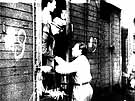
|
|
|

|

|

|

|
|
Click on an image to see a larger, more detailed picture.
|
|
|
|
|
| 1944: Desperate Acts |

|
pg. 561 |

|
|
|
|
| |
 A Jewish policeman shakes the hand of one of more than 1000 Jews who are about to leave the Westerbork, Holland, concentration camp in early September 1944. Of the 1019 Westerbork prisoners who arrived in Auschwitz in early September, 549 were immediately sent to the gas chambers. Among those admitted to the camp on that day was Anne Frank, young author of the famous diary. Killings would continue at Auschwitz for another five months, a fact that is particularly terrible because Allied aircraft had gained the ability to bomb the camp complex in the autumn of 1943.
A Jewish policeman shakes the hand of one of more than 1000 Jews who are about to leave the Westerbork, Holland, concentration camp in early September 1944. Of the 1019 Westerbork prisoners who arrived in Auschwitz in early September, 549 were immediately sent to the gas chambers. Among those admitted to the camp on that day was Anne Frank, young author of the famous diary. Killings would continue at Auschwitz for another five months, a fact that is particularly terrible because Allied aircraft had gained the ability to bomb the camp complex in the autumn of 1943.
Photo: Museum of Jewish Heritage/United States Holocaust Memorial Museum Photo Archive
|
 The Vittel transit camp played a vital role in the murder of France's Jews. Thousands, many of them not French citizens, passed through the camp on their way to larger French concentration camps or to Auschwitz for extermination. The people pictured here were among the 2087 prisoners at Vittel when it was liberated by Allied armies on September 12, 1944.
The Vittel transit camp played a vital role in the murder of France's Jews. Thousands, many of them not French citizens, passed through the camp on their way to larger French concentration camps or to Auschwitz for extermination. The people pictured here were among the 2087 prisoners at Vittel when it was liberated by Allied armies on September 12, 1944.
Photo: Corbis-Bettman / United States Holocaust Memorial Museum Photo Archive
|
 Westerbork
Westerbork
Established near the German border by the Dutch government, Westerbork originally served as a camp for Jewish refugees. With their occupation of the Netherlands in May 1940, the Nazis turned Westerbork into a transit camp with a constantly changing population, while at the same time maintaining a core camp with a stable population of workers. Beginning in July 1942, Westerbork became a way station for over 100,000 Dutch Jews dispatched to the death camps of the East. The barracks served as the last home for thousands of families, including that of Anne Frank. Usually on Tuesdays, thousands of men and women were crowded into cattle cars for their last journey. No one was exempt. After watching the hellish process of deportation, Etty Hillesum, who would herself soon be sent to Auschwitz, reported that "one more piece of our camp has been amputated."
Photo: Rijksinstituut voor Oorlogsdocumentatie / United States Holocaust Memorial Museum Photo Archive
|
|

|

|

|

|
 September 26, 1944: On this day of Yom Kippur, 1000 young boys are assembled at Auschwitz in the presence of Dr. Josef Mengele. Any boy whose head does not reach a board Mengele has nailed to a post is set aside for gassing; See September 28, 1944.
September 26, 1944: On this day of Yom Kippur, 1000 young boys are assembled at Auschwitz in the presence of Dr. Josef Mengele. Any boy whose head does not reach a board Mengele has nailed to a post is set aside for gassing; See September 28, 1944.
|
 September 28, 1944: Boys deemed too short by Auschwitz's Dr. Josef Mengele are gassed.
September 28, 1944: Boys deemed too short by Auschwitz's Dr. Josef Mengele are gassed.
|
 September 28, 1944: The Nazis resume deportations from the Theresienstadt, Czechoslovakia, camp/ghetto to Auschwitz after a four-month hiatus. Among the 2499 prisoners deported on this day is teenager Petr Ginz, a Czech of Jewish background who was the guiding light behind Vedem (In the Lead), a secret "magazine" created and distributed throughout Theresienstadt. More than 1000 of these 2499 prisoners are gassed immediately.
September 28, 1944: The Nazis resume deportations from the Theresienstadt, Czechoslovakia, camp/ghetto to Auschwitz after a four-month hiatus. Among the 2499 prisoners deported on this day is teenager Petr Ginz, a Czech of Jewish background who was the guiding light behind Vedem (In the Lead), a secret "magazine" created and distributed throughout Theresienstadt. More than 1000 of these 2499 prisoners are gassed immediately.
|
 September 28, 1944: Josef Bürckel, Reich commissar of Austria, and his wife commit suicide.
September 28, 1944: Josef Bürckel, Reich commissar of Austria, and his wife commit suicide.
|
 September 28, 1944: The camp at Klooga, Estonia, is liberated by the Soviets.
September 28, 1944: The camp at Klooga, Estonia, is liberated by the Soviets.
|
|
|
|
|
| 1944: Desperate Acts |

|
pg. 561 |

|
|
The Holocaust Chronicle
© 2009 Publications International, Ltd.
|
|
